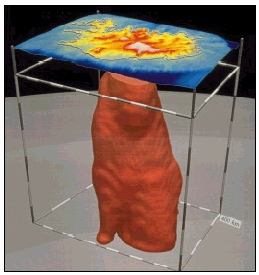The most fantastic aspect of Iceland’s
physical geography is it’s range of processes and landforms. We see everything
from volcanoes to glaciers in one country. Roughly 11% of Iceland is covered by
glaciers, and these glaciers feed the many glacial rivers we find throughout
the landscape. There are also rills and gullies (smaller streams) covering the
island, often spreading in a dendritic pattern, like that of a leaf. Iceland is
full of gravitational water, which is water that follows gravity to the water
table, creating waterfalls. The island’s incredible amount of ground water (along
with the giant glistening glaciers) makes it a beautiful blue wonderland. In
the land of ice however, we also find fire. Iceland is home to 35 volcanoes,
some of which are still active today. As a result of the eruptive volcanoes,
Iceland is covered in flood basalts. Flood basalts are large stretches of land
covered by basalt lava that poured over the landscape after an eruption. Another
aspect that is unique to Iceland’s geography is it’s high latitude. The island
sits just below the Arctic Circle, making it the perfect environment to see the
aurora borealis (a “light show” in the sky due to solar radiation interacting
with oxygen and nitrogen in the atmosphere). Iceland is ultimately a beautiful
and unique environment.
In 1,000 years Iceland may look
different:
Geologically speaking, Iceland is
a very young island, at only 20 million years old. In 1,000 years, I do not
think that Iceland will change significantly because geological processes take
so long to occur. I do believe that because Iceland is a volcanic island, it
may grow bigger in the coming years. Iceland is situated on a “hotspot” which
is a narrow upwelling of magma from the earth’s core, as the magma rises and
cools it creates more land mass. Also, is any of Iceland’s volcanoes were to
erupt in the next 1,000 years the lava flows would harden and become new land. Scientist
know that one of Iceland’s biggest volcanoes, Hekla, has erupted at least 20
times in the last 1,000,000 years.
Three dimensional view of the
mantle plume under Iceland.
In 10,000 years:
Iceland is cut almost directly in
half by the mid-Atlantic ridge. This ridge is exists because the Eurasian and
North American tectonic plates are diverging (pulling away) from one another. As
the plates move Iceland moves with them. In 10,000 years, Iceland may very well
split do to the ridges diverging. Scientists have already found rifts in
Iceland that are occurring along the ridge. The portion of the Earth’s crust
located between the two rift zones, called Hreppar in South Iceland, is
departing from the North American plate.
This picture shows the mid
Atlantic ridge cutting through Iceland
along with the location of its hotspot.
In 1,000,000 years:
I believe that in 1,000,000
years, Iceland will have split due to the spreading of the plates creating two
islands. Though the hotspot that created Iceland may be fixed, the plates are
constantly moving. I believe that as the plates move over the hotspot, a string
of islands may be created similar to the Hawaiian islands. Though in 1,000,000
years, it may only be the very beginnings of this island chain because 1,000,000
years is still a short period of time in geography.
This image depicts the active rift zone that are currently in Iceland.
In Conclusion: Iceland is changing every day and may be more than one island in the future. I believe it's beauty and unique geography will attract people for many years to come.
SOURCES:
http://www.foxnews.com/scitech/2011/07/06/iceland-volcano-to-erupt-again-experts-say/













